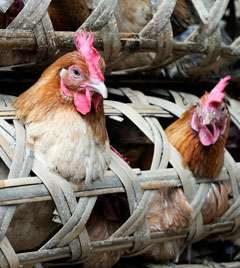Study reveals new details about H7N9 influenza infections that suddenly appeared in China

(Medical Xpress)—Researchers with the Network Dynamics and Simulation Science Laboratory at the Virginia Bioinformatics Institute have revealed new information about the latest strain of type A influenza, known as H7N9, in a report in the journal PLOS Currents: Outbreaks.
Since June 7, 132 confirmed cases of human infection with H7N9 have been reported in China and 37 people have died, according to the World Health Organization. It is the first time human infection with the avian influenza H7N9 subtype has been detected, and researchers fear that this strain may have pandemic potential.
The possibility of an animal source of the infection is being investigated, as is the possibility of person-to-person transmission.
However, most people who contracted the disease reported having contact with live birds in a bird market prior to infection. Researchers at the Network Dynamics and Simulation Science Laboratory found that younger women generally have the most contact with poultry, but it is older men who are experiencing the most infections.
The findings suggest that there is something unique about older men that makes them particularly susceptible to H7N9. Their greater risk of infection is not just because they tend to spend more time exposed to an avian source.
Researchers quickly compiled the data using a variety of available sources to discover risk factors, which could aid in containing the spread of H7N9.
"Normally we have to wait for epidemiologists to collect new data in the early days if an outbreak. We were able to combine data from existing sources in an innovative way to rapidly learn about H7N9 risk factors," said Caitlin Rivers of Plainfield, N.H., a graduate student majoring in genetics, bioinformatics, and computational biology and research assistant at the Network Dynamics and Simulation Science Laboratory.
To contain the spread of this strain of influenza, some Chinese live bird markets have been closed. It may help, but still does not explain the high infection rate of older men. Further studies are required to understand what other factors may be involved in transmission to help contain H7N9's spread.
"In keeping with a commitment to open science, the raw data and calculations are available publicly. We invite others to use and expand upon this work," said Bryan Lewis, a public health policy analyst with the Virginia Bioinformatics Institute.
More information: currents.plos.org/outbreaks/ar … om-poultry-exposure/












